Amongst everything that concerns GST, compliance and registration are very important. Here,Indian Jeweller is trying to help you with few important points to keep in mind.

GST (Goods and Services Tax)
GST is a tax levied when a consumer buys a good or service. The current tax regime is riddled with indirect taxes which the GST aims to subsume with a single comprehensive tax, bringing it all under a single umbrella.
Benefits of GST
According to EY.com, GST has been envisaged as a more efficient tax system, neutral in its application and attractive in distribution. The advantages of GST are
• Wider tax base, necessary for lowering the tax rates and eliminating classification disputes
• Elimination of multiplicity of taxes and their cascading effects
• Rationalization of tax structure and simplification of compliance procedures
• Harmonization of center and State tax administrations, which would reduce duplication and compliance costs
• Automation of compliance procedures to reduce errors and increase efficiency
Getting Registered as GST Taxpayer
Another important aspect in complying with GST is to register the entity as a GST taxpayer.
Some note-worthy points:
1. Existing VAT and service tax payers need not register afresh for GST. Their existing details can be migrated to the GST portal by following due process to enable a single transactional relationship with the government. These entities need to get provisional IDs for the GST portal from their existing registrations with State VAT orService. This provisional ID can thenbe used to login to the GST portal and fill the requisite details for GST registration.
2. As GST is a supply location based tax regime, organizations may have to get multiple IDsregistered depending on their locations.
3. New registrations Enrolment process has closed with effect from 1st May 2017.
The GST registration portal was launched in November 2016, but given the ambiguity around the roll out dates, the process is yet to pick up steam. But there is renewed action on this frontonce again, so we suggest that entities get this essential step done and out of the way as soonas possible. The enrolment schedule for various states is available here.

Do note that the GST registration form is a lengthy one with several fields and also requires you to upload business documents. So ensure that you have the relevant documents handy as soft copies, before initiating the registration process as each section needs to be completed in one go for your data to be saved.
Alternatively, you may use our IRIS GST application that allows you to collect and save details at your own pace. Once done, the data will be uploaded onto the GST portal to finish your registration.
4. Updating your ERP / Accounting Systems
The GST subsumes most of the indirect taxes. Once GST gets implemented, the rate of tax will be based on the destination of supply of goods instead of the erstwhile value added tax at various levels along the supply chain. Tax invoices will now need to include the GST registration number (GSTIN) of the counterparty, HSN (Harmonised System of Nomenclature) code for goods or Service Accounting Codes (SAC) for service etc. Also, when filing returns, companies need to provide further details such as eligibility for claiming input tax credit, whether provisional tax is paid, details of original invoice in case revised invoices are issued etc.
Many of these requirements will require revisiting the existing billing system, the standard chart of accounts and underlying accounting aspects. The ERP/ accounting systems therefore need an upgrade to enable capturing and smooth processing of all the additional information.
5. Meeting the GST compliance requirement
Once the initial migration process is complete, for most entities, compliance with GST will be a monthly affair. While this seems like more than what companies are currently used to (service tax is half-yearly and VAT is quarterly), the reconciliation of supply and purchase data on a monthly basis will improve efficiency when it comes to tax payment and availing of credit, amongst other things.
You can take a look at the draft return formats to get an idea of the kind of information that you need to submit.
GST transition may look like a humongous exercise, but with the right tools and support, it can be done easily, quickly and with minimum disruption to business. While the GST portal allows you to file returns directly, for companies with many records this might not prove to be easy.
Given the volume of data and frequency of filing, a seamless and automated process for the regular compliance requirement will be necessary. With a proficient GST solution, this can be streamlined to a great extent.
The Good and Services Tax Network (GSTN) has therefore appointed GST Suvidha Providers (GSP) to provide services for the ease and convenience of tax payers. IRIS Business Services Limited is one of only 34 companies selected as a GSP, after a comprehensive and stringent evaluation process.

GST Suvidha Providers (GSPs)
The Goods and Services Tax Network (GSTN) which is building the technological infrastructure for the implementation of GST, has finalised 34 companies as the GST Suvidha Providers (GSPs), which will offer support and services to help tax payers and businesses in compliance.
Tata Consultancy Services,Deloitte Touche, EY and Tally Solutions are among the 34 firms shortlisted to provide interface between the new Goods and Services Tax (GST) server and taxpayers. Prominent among the short-listed are Karvy Data Management, Mastek Ltd, MothersonSumi Infotech, NSDL e-Governance Infrastructure, Ramco System, Reliance Corporate IT Park Ltd and Tera Software, according to GSTN. Other firms short-listed include Alankit Ltd, Bodhtree Consulting, Botree Software, Central Depository Services, Computer Age and Cygnet Infotech.
Building of GSP Eco System
The GST System is going to have a G2B portal for taxpayers to access the GST Systems, however, that would not be the only way for interacting with the GST system as the taxpayer via his choice of third party applications, which will provide all user interfaces and convenience via desktop, mobile, other interfaces, will be able to interact with the GST system. The third party applications will connect with GST system via secure GST System APIs. All such applications are expected to be developed by third party service providers who have been given a generic name, GST Suvidha Provider or GSP. The GSPs are envisaged to provide innovative and convenient methods to taxpayers and other stakeholders in interacting with the GST Systems from registration of entity to uploading of invoice details to filing of returns. Thus there will be two sets of interactions, one between the App user and the GSP and the second between the GSP and the GST System. It is envisaged that App provider and GSP could be the same entity. Another version could where data in required format directly goes to GSP-GST Server. The diagram below gives the most generic case.
In the evolving environment of the new GST regime it is envisioned that the GST Suvidha Providers (GSP) concept is going to play a very important and strategic role. It is the endeavour of GSTN to build the GSP eco system, ensure its success by putting in place an open, transparent and participative framework for capable and motivated enterprises and entrepreneurs.
GST Compliance Requirement by the Taxpayer
The taxpayer under GST Regime will have to provide following information at regular intervals:
• Invoice data upload (B2B and large value B2C)
• Upload GSTR-1 (return containing supply data) which will be created based on invoice data
and some other data provided by the taxpayer.
• Download data on inward supplies (receipts or purchase) in the form of Draft GSTR-2 from GST Portal created by the Portal based on GSTR-1 filed by corresponding suppliers.
• Do matching of purchases made and that downloaded from GST portal. Finalize the same based on his own purchase (inward supply data) and upload GSTR-2
• File GSTR-3 created by GST Portal based on GSTR-1 and 2 and other info and tax paid.
• Similarly there are other returns for other categories of taxpayerslike casual taxpayer or composition taxpayers.

Concept
It is expected that the GSPs shall provide the tax payers with all services mentioned above in addition to maintaining their individual business ledgers (sales ledger and purchase ledger) and other value added services around the same. Another important service expected from GSPs is the automatic reconciliation of purchase made and entered in the purchase register and data downloaded in the form of GSTR-2 from the GST portal. In additional there will be sectorspecific or trade specific needs which the GSPs are expected to fulfil. The conceptual diagram depicting the same is as given below.
While the GST System will have a G2B portal for taxpayers to access the GST System there will be a wide variety of tax payers (SME, Large Enterprise, Small retail vendor etc.) who will require different kind of facilities like converting their purchase/sales register data in GST compliant format, integration of their Accounting Packages/ERP with GST System. Similarly, the specific needs of an industry or trade could be met by GSP. In short, the GSP can help the taxpayers in GST compliance through their innovative solutions.
Design & Implementation Framework
Tax payer’s convenience will be a key in success of GST regime. The tax payer should have a choice to use third party applications which can provide varied interfaces on desktops, laptops and mobiles and can connect with GST System. The GSP developed apps will connect with the GST system via secure GST system APIs. Majority of GST system functionalities related to taxpayer’s GST compliance requirements shall be available to the GSP through APIs. GSPs may use GST APIs and enrich and enhance the tax payer’s experience. (The APIs of GST System are RESTful, json-based and stateless). GST System will not be available over the Internet for security reasons.
The production API end points can only be consumed via MPLS lines. All APIs will be accessed over HTTPS protocol. The benefits of API based integration are:
• Consumption across technologies and platforms (mobile, tablets, desktops, etc.) based on the individual requirements
• Automated upload and download of data
• Ability to adapt to changing taxation and other business rules and end user usage models.
• Integration with customer software (ERP, Accounting systems) that tax payers and others are already using for their day to day activities
Courtesy: http://www.gstn.org/
and http://www.irisgst.com/
Be the first to comment